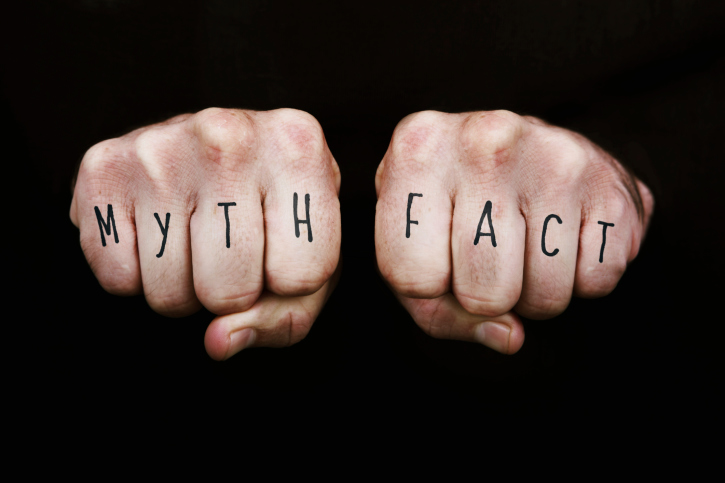Customer retention marketing efforts and the adoption of loyalty programs has been on the rise for businesses large and small.
According to Colloquy’s census, specialty retailers like coffee shops, boutiques and mom-and-pop retail stores have seen a 115% increase in loyalty program memberships over a six-year time span. As of 2015, more than 3.3 billion U.S. consumers are part of customer loyalty programs (a 26% increase since 2013). And this year alone, big businesses like Dunkin’ Donuts, Krispy Kreme, Taco Bell, Macy’s, AT&T, Chili’s, Rite-Aid, and more implemented loyalty programs.
While loyalty programs become more popular, affordable, and accessible for small businesses, certain myths associated with these programs grow, too – Myths that could prevent your business from growing and gaining loyal customers.
Whether you’re considering a loyalty program for your business, or already have one in place, it’s important to separate fact from fiction. To decipher the misconceptions swirling around out there, here’s a list of five myths about loyalty programs debunked.
Myth #1: A loyalty/rewards program is just giving away free stuff.
The purpose of a loyalty program is to increase repeat business. To do so, customers typically earn rewards, which can be anything from a free cup of coffee to a $10 coupon.
Yes, loyal customers are rewarded with free stuff, but that customer has likely come into your store more frequently to earn that cup of coffee or coupon than they would have without being part of a loyalty program.
Statistics show 65% of customers that belong to a loyalty program frequent the store more often, and 64% say they spend more at each visit.
According to Fivestars analysis, businesses who send promotions as part of their regular loyalty program see an increase of in-store visits by 70 percent. In addition, those promotions also result in a 70% increase in full-priced visits at a later date. Yes, the initial promotion included a discount or free item, however, it also drove additional full price spending that may have never occurred otherwise.
In addition, giving away discounts or free items, which increases visits, allows businesses to collect data on customer behavior. You can see how frequently customers come in and monitor which offers entice them more. This allows you to create different segments of customers to tailor marketing messages, and provide more effective offers.
Myth #2: Customers are bothered or annoyed by text message promotions
One of the great benefits of a loyalty program is being able to reach out to customers when you want, which includes sending text messages.
Ninety-four percent of loyalty members want to hear from the brands they’ve signed up with.
While some people believe customers are turned off by promotional texts, a recent survey suggests otherwise. Seventy percent of customers say they like receiving texts from brands, and 50% say they’d like to hear from businesses via text 1-5 times a week.
You need a customer’s permission to text them, of course, but texting has become so mainstream that many customers embrace the trend.
Also, Fivestars members have the option to sign up for text messages, emails, mobile app notifications, or all of the above, and the unsubscribe rate for text messages remains less than 1 percent.
Myth #3: Today’s loyalty programs don’t cater to an older demographic.
You might think that older customers aren’t interested in loyalty programs, but you’d be wrong. Data shows 58% of 45-54 year-olds, 50% of 55-64 year-olds and 44% of 65+ year-olds belong to store or membership programs.
It’s true that the younger generation leads the pack with loyalty memberships, with 71% of 25-34 year olds belonging to a program, but the older generation is still signing up for rewards.
Businesses shouldn’t make assumptions about their customers, especially based on age. Customers are valuable at all lifecycles, and adding a loyalty program to a business that caters to an older crowd could be the catalyst to increase sales.
Myth #4: A loyalty program functions on its own after initially signing customers up.
A loyalty program requires continuous effort to be successful. After the initial blast of sign ups, business owners must create marketing campaigns that target specific audience segments, track customer behaviors and continue to attract new users to the program.
For a loyalty program to work, you can’t “set it and forget it.” Like any promotional tool, a loyalty program is only as good as the work you put into it.
Myth #5: Loyalty programs involve punch cards.
Some loyalty programs come with a punch card, but not all. Some customers prefer the low-tech card option; others want a fully digital program that doesn’t require a wallet full of hole-punched cardboard.
A recent survey shows 36.8% of customers like the card-based loyalty programs, while 33.3% like digital. Right now, it seems like audiences are split; however, that same survey shows customers are 59% more likely to join a loyalty program if the company has an app. This trend shows an increasing demand for digital programs in the near future.
Do you have any concerns about starting a loyalty program at your business? Have you heard a myth or two about loyalty programs that you’d like us to provide the facts about? If so, share your thoughts in the comment section below and we’ll help you out.






Leave a Comment